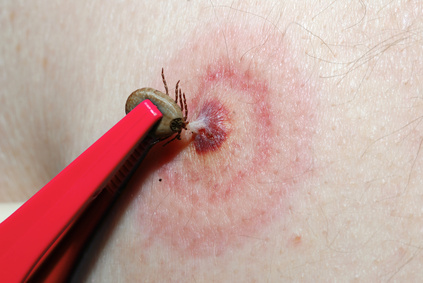|
The Lyme Disease Bulls Eye Rash
The Lyme disease bulls eye rash is one very characteristic sign of a Lyme Disease infection. The rash, resulting from exposure to the spirochete bacteria Borrelia burgdorferi, may feel warm to touch, and vary in size, shape, and color. The site of the bite will be a simple red spot to start but gradually spreads as infection progresses. The interior of the infected area will be lighter in color producing the bull's-eye or target appearance. Note that if there is no infection by the Lyme disease bacteria, there may still be a red spot from the bite and, of course, there is always the possibility of infection from a non-Lyme organism.
Note in the photo that the tick is quite enlarged as it is engorged with blood. Also, removal using tweezers to grasp the body of the tick is incorrect as this could push its stomach contents (including bacteria) into the victim.
While the Lyme disease bull's eye rash is characteristic, it only appears in about 30% of the bites. Some bites will not develop the rash at all, so you should be aware of other
early symptoms of Lyme disease
that may appear within a few days to a month. Some people may develop these symptoms and not relate them to an earlier tick bite.
If you have been bitten by a tick and do not develop the rash or other early symptoms you should be alert to the
later symptoms of Lyme disease
(as it enters the chronic phase) as these can mimic many other chronic diseases.
As diagnosis is sometimes difficult and symptoms vary and show up some time after infection, awareness of the prevalence of ticks and Lyme disease and its seriousness is very important.
|
Keep up to date with
valuable insights into
pain management via
a healthy lifestyle.
Receive the monthly
Natural Pain Relief
Guide Newsletter.
News articles, health
tips, specials, freebies.
Enter your email and name
in the form to the right.
|
|
|









New! Comments
Have your say about what you just read! Leave me a comment in the box below.